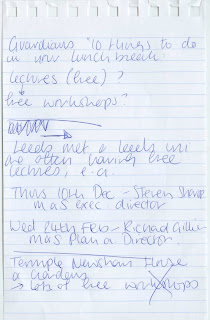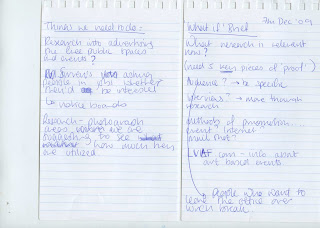What problem did you indentify?
After exploring a range of possible ideas, as a group we decided that our initial problem was the lack of free public spaces, particularly indoors. Following the first week's research and feedback we re-evaluated and decided that the real problem was that the people of Leeds, specifically office workers) aren't informed enough about the quantity and variety of free public spaces available to them.





What Evidence did you find to support your decisions?
My role in the group was primarily research and ideas based; although most of the project decisions were discussed and made as a group. I did a lot of internet based research into similar projects in Leeds and other cities, which proved that nothing notable had been suggested in the past, or appeared to be in progress which indicated the need. Most of my research was into exsisting promotion of the free public space available, the locations, and other free public attractions. This proved that the spaces and venues are in fact there; simply not advertised successfully enough. For a lot of my research, I tried to use more trusted, less subjective websites such as government, respectable online newspapers and tourist information type sites. However, I also did a lot of research into the idea of the 'lunch hour', to get an idea of how people spend theirs. I found that looking on blogs where office workers are actually discussing this exact subject aided me in understanding the needs of the office worker. Although not primary evidence, I think it's a fairly unbiased, way of investigating peoples opinions. Through this research I came across the fact that the average office worker spends approximately 240 hours a year on their lunchbreak. As a group we all felt that this would be one of our leading arguments in persuading and promoting free public spaces as an alternative to sitting at an office desk.

After we decided to promote our website using a free lunchbox, I researched the variety of different lunch boxes available today to help us decide upon a simple and appropriate design for ours.
"Eat outside the box". The group agreed it fitted our concept really well on a number of different levels.


I was not involved in the delivery of the questionaires that we issued, however they were discussed as a group. All of our lines of enquirey were discussed as a group before deligating who would complete each task.
What methods did you use to gather your evidence and what forms did it take?
As a group we used both primary and secondary, qualitative and quantitative methods to gather our research. Methods I used for research:
As a group we used both primary and secondary, qualitative and quantitative methods to gather our research. Methods I used for research:
Primary qualitative methods; the propsed questionaires.
Primary quantitative methods; written observations on the overcrowding of Leeds city centre and lack of obvious/advertised public spaces.
Secondary qulitative methods; Internet research (primarilly articles, blogs, govenment sites, city information and tourist sites, comsumer shopping sites etc)
Secondary qualitative methods: discovering amount of possible free locations for people to go to on their lunch hour including parks, squares, galleries, and free lectures and workshops. Also facts and figures with regards to time spent on lunch ours per year.
I think that the internet research was useful in terms of ideas and bringing us to our solution, however I think the most useful methods of research were the questionaires and the first hand photographs of areas of the city centre. I think this purely because this was information gathered first hand an so more reliable. Also I think in our project, we really needed to identify the problem and the need for our campaign by speaking to real people about it rather than looking at secondary information and making our own assumptions. The internet research was very useful in terms of time-saving. I think due to the short length of the brief, without internet research it would have been far more difficult to quickly try to locate and find information about existing free public spaces in Leeds.
How did these inform your response to the problem?
I think that the internet research into how people do already/ could spend their lunchbreaks helped us to find our target audience; i.e. office workers. The questionaires (particulary the one given to actual office workers) helped us to varify our problem and also learn a little more about what people do/want do do with their time. It proved that the majority, given more encouragment and advertising they would like to spend their lunch hour in a different way to the way that they currently do. I also think that the visual research from the centre of town, and the internet research into how well the free public spaces of Leeds are advertised in terms of online and maps was crutial in the motivation of our idea and final solution.
What methods did you encounter as problematic?
I think that internet research is always problematic in the way that you really cant trust a lot of what you read. I also think that our first questionaire was perhaps not specific enough, and angled to encourage the answers we wanted. Also this was not given to our target audience as we hadn't yet identified them yet.
How did you overcome this?
We later issued a second questionaire which was far more open and given to office workers. In terms of my body of internet research, I was selective in what I put forward to the group as evidence; I included information that was objective as possible, such as maps, statistics, council propsals.
What research could you have carried out that would have proved more useful?
I think that I could have carried out more research into the website design for our campaign. I was only involved in the more content based area's of the website such as the map locations and the ethos; while Nick and Arthur worked on the design. Towards the end we almost had two quite stylistically different designs, but both appropriate in different ways. As a group we discussed them and agreed on a comprise that worked really well in my opinion. However, I think if more research had been carried out into websites and how they appear according to what they are advertising, I think we may have bypassed this issue.
5 Things that you have learnt about the design process over the last two weeks:
- The better and the more you know about something, the easier it is to solve visually
- Working in a group requires a lot of communication in terms of every design desision; however big or small
- When working in a group it is sometimes nessasary to stand down slightly in terms of the more exciting design process in order to make the best of the technical skills of other members of the group
- the research element of a project is completely vital to the proper development of an idea/solution
- the value of primary evidence over secondary at times
5 Things that you would do differently next time:
- I think that we worked really well in the way that we met everyday to discuss the progress of the project, however I think that next time there needs to be more communication with regards to the design decisions
- I think internet research is something that I'm quite strong at, next time I need to get more involved with primary hands on research, rather than just discussing what we could do, actually be involved in retrieving the information
- I think that as a group we could have conducted more primary research
- I also feel that we could have conducted some of our research in a more interesting and inventive manner
- I think that trying to involve myself more in the design element would be difficult at first because I lack a lot of the computer based skills that other people in our set have, however I wont improve unless I keep using the programs. I enjoyed my small part in the map design; maybe next time I should try something a bit more challenging.


















No comments:
Post a Comment